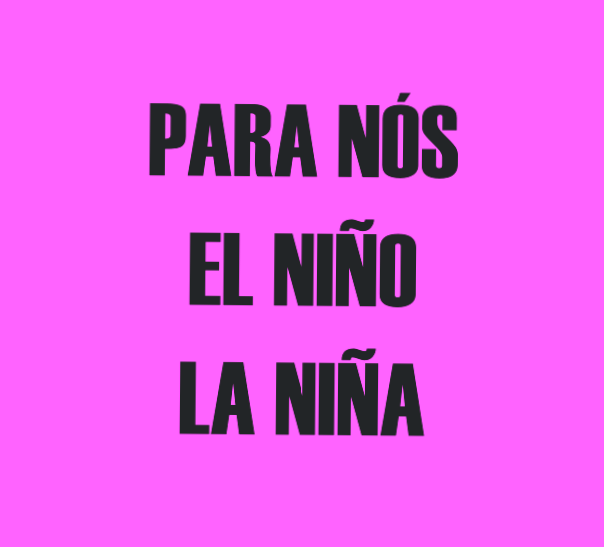
This recipe-essay is also a hyperlink-file, a plot-map, a memory-process, and an oracle memory-tarot card.
Here, I plant some succulent, weedy, and carnivorous words, sisters of stem, leaf, sap, seeds from afar, from here, from wherever.
Panorama I

There is no linearity. Some things come first and happened in the middle, others are happening now as I write. Seasonal cultivations, quarterly harvests, weekly germinations, everyday cultures… Desires of the physical-virtual trajectory of a user body, earthlogged between offline perspectives and what connects an autonomous-temporary network of hybrid, non-binary memory. Part of these notes have been organized on the central wall of the atelier
Panorama II
Something in rhythm and rites guides my body as I wander along the path I make between a point in Jaguare and downtown. Along this journey, I encounter ipê trees, jacarandá, sibipiruna, aloe vera, annatto, palm trees, aveloz, aroeira, and mororó; plants, trees, forage that we recognize, forget, turning the corner. In a game of hybrid memory, time is a braid in the making. While I write, the timeline is debated in Congress, the weaver ants climb on the embauúba tree, a new cold front has arrived in São Paulo, Charmaine, Beatriz, and Vânia dreamed. Abi lights an orange candle in the space, and Elly writes and observes concentrated, by my side, Maria sews a painting, and a little further, a reset. Marina organizes confetti, Diogo a balloon, and on both hemispheres, wars and genocides are ongoing.
I recognize the metabolism of this ground.

// Strategies
I apply the pedagogy of garden beds, generating methodologies around what is already planted, such as an analysis of the organized public/private management relationships in the urban landscape. I plan a small ecosystem based on the local climatic experience and its connection to the whole. I carry with me some seeds: corn, beans, pumpkin, sunflower, and fava beans dedicated to the gods. With them, I aim to sprout stories, weave new or different memories of encounters we haven’t lived but that reside within us. Carrying, exchanging, and planting these seeds wherever I go speaks to the connection I aim to create because each of them, in its culture, leads to diverse ancestral-present places, temporalities, and humanities.
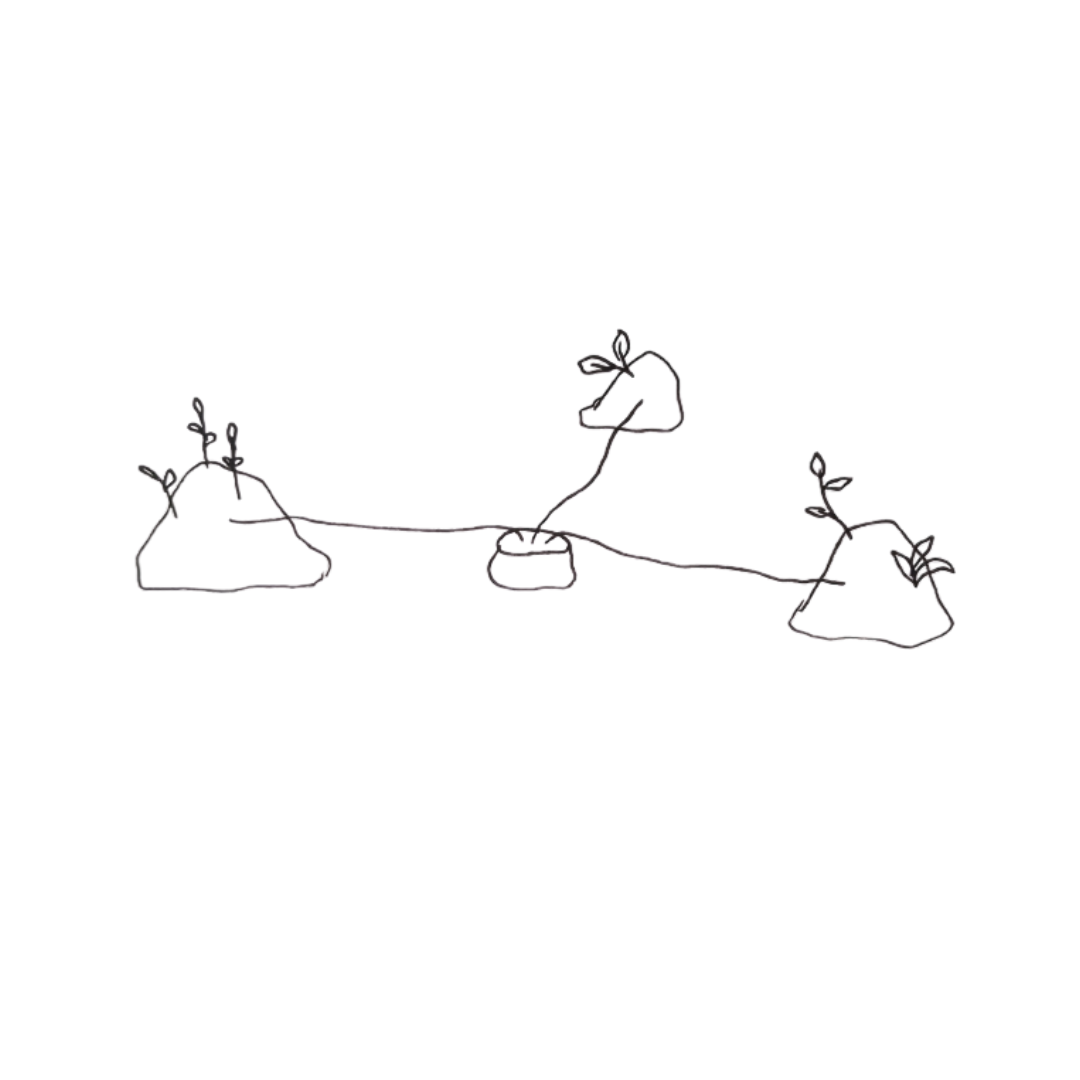
soil_
I have soil briefly harvested from a flowerbed in Praça da República… As I gather and observe the landscape, girls who were active in the square ask me what I am doing, and in that, we exchange thoughts on planting in enclosed spaces, the absence of light and air, and who owns the soil in Praça da República… until they tell me about the flower market. In Largo do Arouche, the soil has value, 10 reais per 1kg bag. The soil sold in Arouche comes from the interior of the state. The earth trembles in the truck that circulates from within to within in the redistribution chain of the land, destined for cultivation, the works, enterprises, and properties. These scales are interpreted here as determinants of the current landscapes. In the colonial way of inhabiting the land. The land does not leave the earth; it only changes within it, gains value, measure, weight. The earth I hold in my hands becomes a bed for the seeds in a ‘muvuca’ [mess]. The earth trembles.
water_
Charlene asks me if the rope guides the water…
I find that so beautiful to think about…
Later – and what remains for you, Dyó?
I respond that for me, memories…
For us, el niño y la niña.
To keep the system irrigated, I experiment with sisal threads connected between a small clay pot and the small mounds of densely planted soil in ‘muvuca’. The rope guides the water from the pot to the small mounds of soil that were arranged directly on the ground, aiming to infiltrate the concrete, reenchant in the attempt of ‘damage,’ as a weed even, besides causing the necessary cracks for a pivot root.
light
Now it’s winter, and soon it will be spring. Around 3:40 PM, the sun approaches and enters. I observe between late July and early August…
After these months, the light retreats, bathing only the floor of the balcony…
From the balcony, I observe what seemed to be a young embaúba; upon closer inspection, Rômulo
says it could be another, remembering the number of leaf tips of embaúba and how the recipe for tea was taught to him. I remember that embauúba is very generous, it is a home, a shelter… above, a bird that we wouldn’t be able to identify now. Its fruit and leaf are food; inside the hollow stem, ants reside, outside the sap is sought by cicadas, and below near its roots, seedlings grow in partial sunlight. Embaúba, a pioneer, acts in the regeneration of degraded forests throughout Brazil.
I don’t see them around here often. In Niterói, it’s my neighbor.
The glass walls provide good lighting, the seeds begin to sprout
in a few days, some awaken before others, and the soil from Arouche and República makes sense for some cultures.
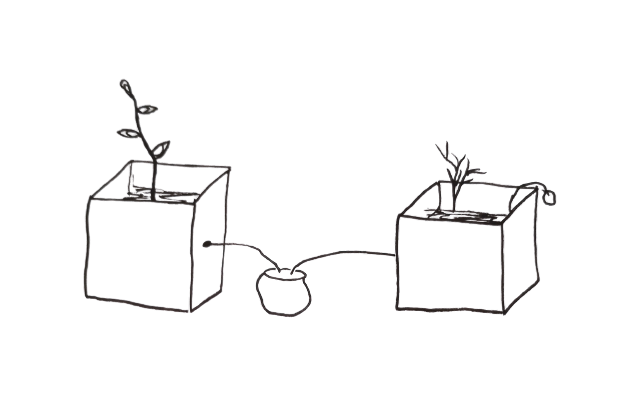
I ask and map:
Where can cerrado and Atlantic Forest be found in the middle of the city, in the gardens of B. Marx, amid artificial landscapes and exotic vegetation?
There are about 3 Urucum trees on São Bento Street.
At the intersection of São Bento Street and Major Daniel, there are also some in a flowerbed near ‘Estadão.’
I harvested some leaves and fruits to make tea and continued a notebook in which Urucum is a storyteller. The oldest tree in the city is a fig tree; we did not meet during my stay.
Panorama III
There is a storm underway. I am opening a tarot card for each interested person. 3 cards sometimes; the time that flies seems to linger.
At 3 PM, someone leans on the balcony observing the movement outside.
It was clear like a predictable day in spring.
At 3:40 PM, we go out in a group to contemplate a storm that washes the buildings and streets.
We feel it; the earth does too.
The rain passes, the day regains its illumination,
the sun has always been there.
Time
When I wrote notes about hybrid crops and other memories of sap,
I was interested in performing Atlantic bio-philias, for which my location-desire-research
led me to think about organicities in accordance with the earthy, decomposed collection.
An ephemeral circuit of art offering, altar, cultivation, medicine, and sharing.
The braid is this connecting symbol, technical, artisanal, and ancient.
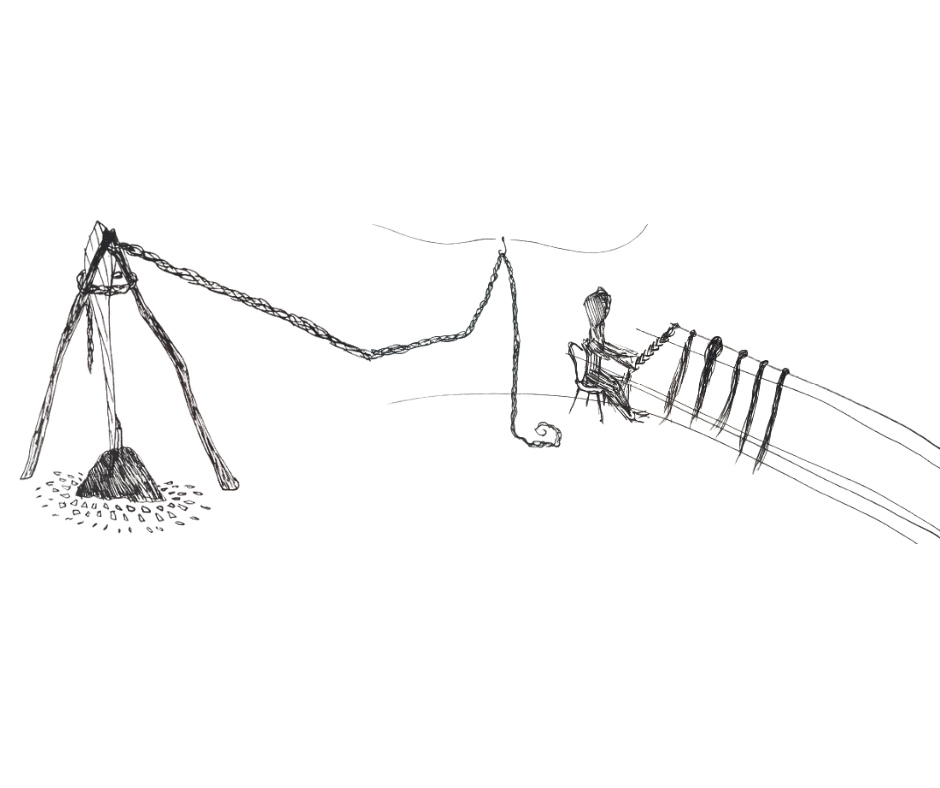
In the center of the São Paulo landscape, I contemplate the plastic, industrial nature.
In worship of what does not decompose as an object-collection.
A new braid is forged, no longer as ‘ybyratyba’ but in another configuration. Now synthetic, to contemplate the ancient ‘kaa’guaçu’, now ‘ka’a itá-guacú’ (large stone forest). The synthetic braid that connected an altar inside the studio to the outer part of the balcony has grown to over 50m and was created with various hands: Maria, Abi, Mayara Velozo, Nicolau Andreas, and Luä Ayo.
Capillary concrete.
Layers that involve the raw state of matter and the industrial reflection incorporated into the body as an extension or even a connector of plastic perspectives. This braid now walks through other landscapes.
I remember that in the big cities of this part of the world, soil, water, and air are in the process of contamination, if not already polluted or deforested, and the increasingly intense heat also affects the production of hybrid memories between the human body and plants; everything dries up. The attempt at cultivation is surrounded by this ongoing world process…
I ask and map while smoking a cigarette.
How many sword plants are needed to filter the air?
How many aloe vera plants will be necessary to remember that the gossip is strong?
Meanwhile, in the river, poetics of contamination:
Searching for extinct, vulnerable, rare, and living vegetation.
Mainha, Mapô, and Pâmela help me search for and carry giant aloe vera plants.
When I return, I connect with other structures_bodies_institutions and landscapes.
I want to exchange cultivation strategies, interchange the ground we tread,
from inside to inside the earth. I receive heirloom seeds from Mariana, eye of the bull seeds from Abi, bean and fruit seeds from Elly, fruitful seeds from Crystal, compost seeds and soil from Sérgio, and all of this conglomerates in the mounds of soil, in conversations that for some reason led us to the cultivation of ideas, processes, and plantations.
Until we established radical seedbeds.
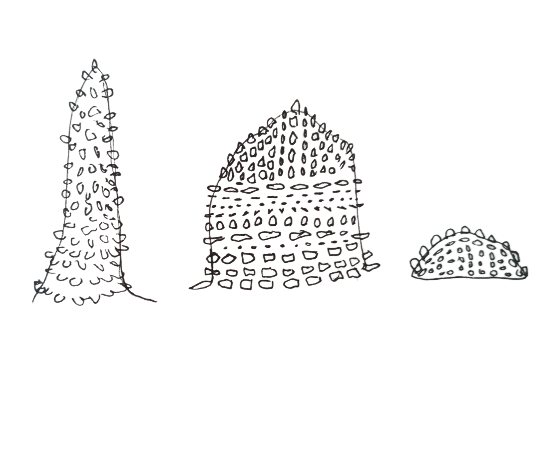
The radical seedbed is conceived from perspectives of cultivation originating from Abya Yala and Asia, involving technologies like ‘muvuca,’ ‘mutirão’ [collective work] , and seed bombs. It is a way to redistribute the natural landscape with fruits, legumes, herbs, and trees.
Reforesting thought
Instructions for carrying out the radical seedbed:
Have some seeds, clay, soil, and water at hand.
The first step is ‘muvuca,’ followed by the sculpting process involving clay within the ‘muvuca,’ using water to facilitate handling. After reaching the sculpture’s shape, fill its surface with other seeds. Let it dry for 24 hours in the shade before placing it in a designated planting area. The seedbed should distribute the seeds according to the climatic conditions of the landscape where it is deposited, requiring no soil preparation or continuous irrigation. As it rains, life in each seed is summoned to awaken.
During the open field, we conducted an experience around the seedbed. Participants in this moment included Elly, Maria de los Angeles, Abiniel João, Beatriz Cruz, and Rodrigo Lopes. The seedbeds of this day are destined for dispatching through flowerbeds and squares in the vicinity.
Angiosperms teach practices of return.
Intercropped cultivations:
With our feet wet from the Atlantic, during a new moon in Libra, partner Pedra Silva and I gathered to act on three beaches in Fortaleza in the exercise of generating ‘appearances by the sea,’ along with seeds, sand, clay, seawater, beetles, dogs, humans, plants, and the sunset of each nightfall. Like an exchange between Pedra’s ‘Mem(Orí)as de quintal’ and the ‘Radical Seedbed’… an exchange of the ground we tread. The appearances consist of organic materials collected from the vegetation along the city’s shores; storytellers and remembrances of the untold, whose archive in presence mixes in the breakwater in constant revitalization, modernization, persisting plastic and concrete amidst the dunes.
The ‘appearances’ here are a manifesto of the latent ancestral between beach and interior, between the cosmologies of the sea that bathes a common coastline, the pendular trace of a fishing, of a dance ritual in the sand, of a touch for the queen of waters, a beach dispatch, a dive, the residue of the invisible that resides on the edge, at the tip, and underneath the bridge, on the tangent of high tide, in what is brought and carried in the ebb and flow of the waves. We planted sunflowers. We dedicated, to each point along the shore where we were, and to each group of appearances, a root food, as a correspondence for the land, waiting to be planted sometime forward, backward, and here in the middle. Yams, cassava, sweet potatoes. Partners in the strength of arms that incorporate what appears, what warns, what denounces, what nourishes and scares at the same crossroads. Maybe none of this captures the days of work we had, but the record remains.
On the hottest days, I am on the verge of becoming a xerophyte.
(Those that resist the heat, dance with the sun)
In a thermal sensation of 48°C, I think of Abya Yala, other names for this territory before the Americas. I connect to the hungry mist active among mountains in the other

tropics. In this affectionate invitation from Rodrigo d’Alcântara, I create an exchange between this ground at a distance and in constancy, as a way to articulate fables beyond the Brazilian perimeter. The drawings led by Rodrigo shape the landscape, whose extension articulates with Ceci, Simone, and Bento, as a real-virtual heat zone that establishes transborder memory-prints amid the climate crisis. A ‘Guanabara Glitch,’ an appearance in arrowed forest, typographies to remember Abya Yala.
The network goes down when the rain floods, the batteries run out.
We return to the flowerbed.
In the absence of areas with soil, we reenchant the concrete.
Which now, in riot, germinates.
References
[1] Affectionate Yard – Várzea 2022 (nacampo.org) / Pedagogy of Flowerbeds section
[2] Colonial Dwelling, Decolonial Ecologies, Malcolm Ferdinand
[3]Ybyrá.Tyba: Notes on Hybrid Cultivation and Other Sap Memories – ArtsEverywhere
Rastros de Diógenes was a resident of Pivô Pesquisa 2023.

 Português
Português